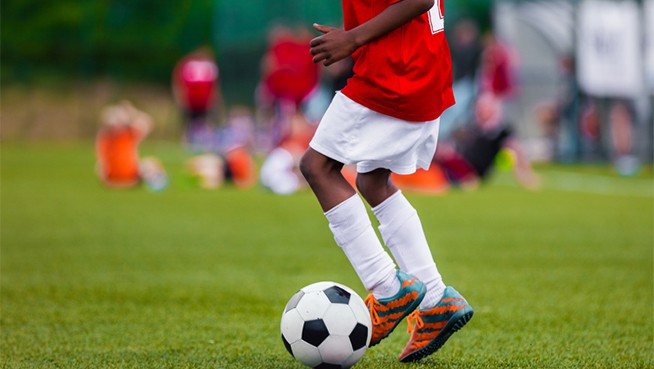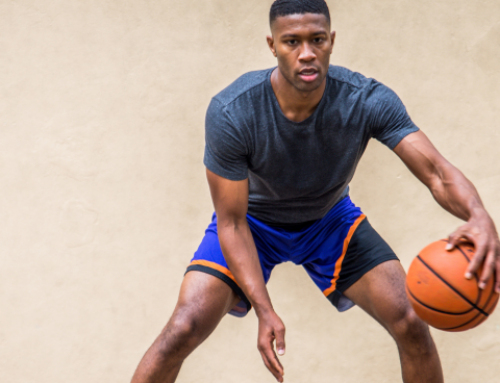3 Ways to Increase Your Vertical Jump During Basketball Season
Basketball season is in full swing and I’m getting questions from athletes, coaches and parents about improving vertical jump. This is an especially frustrating question for me because it’s something that should be asked in April, not in January!
We could improve vertical jumping ability, among other things, tremendously in the offseason, but during the heart of the season, it’s extremely difficult to make noticeable gains in the vertical jump.
But it’s not impossible. Although it may not be the ideal timing, there are still solutions.
If you want to jump higher during basketball season, try these three tactics.
1. Sleep More
If there’s one surefire way to decrease performance, it’s sleep deprivation.
One study in the International Journal of Sports Physiology and Performance discovered that one night of sleep deprivation led to decreased jump performance and cognitive function the following day due to the disruption of recovery. The sleep-deprived athletes also reported a higher level of perceived soreness.
On the flip side, sleep can also be a weapon that drives improvement.
During the season, basketball players do tons of plyos, sprints and other high-intensity movements that are built into games and practice. Those actions are typically how we would approach jump improvement in the offseason, but doubling up and adding even more of them to an athlete’s workload may not be the best choice for their health.
This is why helping someone jump higher is much more complicated in January than it is in April. We’ve lost the time and space needed to use our biggest training tools.
Sleep, however, can make a difference. Given what we know about sleep deprivation and lack of recovery, better sleep will boost your performance.
Having a high level of physical readiness every day not only allows you to perform at a high level, but it also allows you to train according to your in-season program, which is likely focused on strength and can increase force production qualities without having to jump in training.
Being able to sleep more or improve overall quality of sleep can enhance your jumping ability by allowing you to train harder and recover more optimally without further overloading your system.
Three easy tips for improving sleep are:
- Get off your screens at least an hour before bed. Turn off your TV, put your phone somewhere you can’t easily reach it and really focus on getting ready for bed with the intentions of quality sleep.
- Set a bed time. Yes, like your mom used to do. Give yourself a bed time by reverse engineering what time you need to go to bed in order to get 8.5 hours of sleep, based on what time you wake up. If you have to wake up at 6 AM, make sure you’re in bed by 9:30 PM.
- Get some sunlight during the day. Go outside. If you’re inside, look for windows with sunshine streaming through them. Seriously. Be in as much natural light as you possibly can. This keeps your circadian rhythm healthy, which helps you maximize daytime energy and improve night time sleep quality.
Try these simple tips and I guarantee you’ll see an immediate impact in your sleep quality and quantity. If you really want to jump higher during your season, sleep is one of your most powerful weapons.
2. Lose Fat, Build Muscle
Another surefire way for most athletes to decrease their performance is to gain fat. Losing fat, however, turns out to be really good for most athletes.
During the season, it’s common to lose weight. But losing weight and losing fat are not one in the same. Many times, water loss and muscle loss can account for more of an athlete’s in-season weight loss than actual fat reduction. It may be common, but it’s not ideal. You want to maintain muscle mass and hydration levels in-season, even if it means the scale doesn’t change much.
Altering body composition by increasing or maintaining muscle mass and losing fat is the route you want to go. You can alter body comp without losing performance and there are many ways to accomplish this. Diet is actually one of the most controllable things in an athlete’s life.
Proper nutrition takes great planning and commitment, but it’s not as hard as people think. It’s also almost totally in the athlete’s control, unlike many other aspects of being an athlete (travel, game times, schedules, etc.).
Everyone’s diet will look different, and the idea isn’t to have a “perfect” diet. It’s simply to do better than you are right now and keep that momentum going. Here are some easy check points to get you started.
- Find your estimated Total Daily Energy Expenditure: Body weight x 16 (if you’re active) or 18 (if you’re extremely active).
- Eat that many calories per day to maintain muscle mass and energy levels. So if you’re 170 pounds and you’re extremely active, you should eat 170 x 18 calories per day, or 3,060 calories.
- If you’re looking to slim down, eat slightly less than your TDEE while still consuming roughly 1 gram of protein per pound of body weight per day.
- Experiment and adjust. Nobody can give you the perfect diet. You have to figure out what works best for your body and lifestyle.
When your diet is in check, your training and recovery will follow suit.
Again, we’re looking to maximize in-season training by increasing strength and muscle mass. If you end up just maintaining your strength and muscle mass, that’s OK, but the thing we definitely want to avoid is losing strength and muscle mass during the season.
Jumping is a powerful movement, and how strong you are in comparison to your body weight is a part of the formula that determines how high you can jump. Carrying less mass (fat) while being able to produce the same or a higher amount of force is a surefire way to jump higher.
3. Re-Think Recovery
The third and final way to think outside the box and make vertical jump gains mid-season is to re-think what you’re doing for recovery.
For many athletes, recovery simply means “rest.” Rest is absolutely critical, but I think that the real key to consistently feeling fantastic is to dial in both your rest and your recovery.
I think of them as two separate things. Rest is mainly sleep and staying off your feet. In other words, it’s doing absolutely nothing. Recovery, on the other hand, should be active and intentional.
This is where active recovery modalities like muscle stimulation, isometric holds, A.R.T., chiropractic care, and RPR come into play. These are all active, intentional and low-stress forms of recovery. These items don’t directly target the vertical jump, but they absolutely enhance some of the factors that impact how high you can jump.
For example, isometric holds have been closely linked to improved tendon health.
In-season, basketball players’ tendons are under an immense amount of stress and can often results in things like jumper’s knee, Achilles tendonitis or other tendon-based aches and pains that will strip your vertical away from you. Combatting that with isometric therapy rather than “rest, ice, compress, elevate” is going to not only heal you faster, but also help you maintain the strength and jumping ability you possess.
Re-think what recovery means to you. Aggressively attack those aches and pain with intelligent methods that will truly help your body adapt and regenerate.
The common theme here is that vertical jump improvement is very possible during the basketball season, but you must think outside the box. You must be willing to dedicate serious time and energy to things like sleep, diet, in-season training and recovery.
You’re already doing a ton of jumping inside your sport, so adding more jumps to your workouts likely won’t do much good. However, you want to focus on the things that can enhance your jumps that don’t require additional jumping.
If you do, you’ll safely be on your way to new heights.
Photo Credit: FatCamera/iStock
READ MORE:
- The Simple Hack That Instantly Increases Your Vertical Jump
- 4 Vertical Jump Training Mistakes
- 5 Workouts to Increase Your Vertical Jump
RECOMMENDED FOR YOU
MOST POPULAR
3 Ways to Increase Your Vertical Jump During Basketball Season
Basketball season is in full swing and I’m getting questions from athletes, coaches and parents about improving vertical jump. This is an especially frustrating question for me because it’s something that should be asked in April, not in January!
We could improve vertical jumping ability, among other things, tremendously in the offseason, but during the heart of the season, it’s extremely difficult to make noticeable gains in the vertical jump.
But it’s not impossible. Although it may not be the ideal timing, there are still solutions.
If you want to jump higher during basketball season, try these three tactics.
1. Sleep More
If there’s one surefire way to decrease performance, it’s sleep deprivation.
One study in the International Journal of Sports Physiology and Performance discovered that one night of sleep deprivation led to decreased jump performance and cognitive function the following day due to the disruption of recovery. The sleep-deprived athletes also reported a higher level of perceived soreness.
On the flip side, sleep can also be a weapon that drives improvement.
During the season, basketball players do tons of plyos, sprints and other high-intensity movements that are built into games and practice. Those actions are typically how we would approach jump improvement in the offseason, but doubling up and adding even more of them to an athlete’s workload may not be the best choice for their health.
This is why helping someone jump higher is much more complicated in January than it is in April. We’ve lost the time and space needed to use our biggest training tools.
Sleep, however, can make a difference. Given what we know about sleep deprivation and lack of recovery, better sleep will boost your performance.
Having a high level of physical readiness every day not only allows you to perform at a high level, but it also allows you to train according to your in-season program, which is likely focused on strength and can increase force production qualities without having to jump in training.
Being able to sleep more or improve overall quality of sleep can enhance your jumping ability by allowing you to train harder and recover more optimally without further overloading your system.
Three easy tips for improving sleep are:
- Get off your screens at least an hour before bed. Turn off your TV, put your phone somewhere you can’t easily reach it and really focus on getting ready for bed with the intentions of quality sleep.
- Set a bed time. Yes, like your mom used to do. Give yourself a bed time by reverse engineering what time you need to go to bed in order to get 8.5 hours of sleep, based on what time you wake up. If you have to wake up at 6 AM, make sure you’re in bed by 9:30 PM.
- Get some sunlight during the day. Go outside. If you’re inside, look for windows with sunshine streaming through them. Seriously. Be in as much natural light as you possibly can. This keeps your circadian rhythm healthy, which helps you maximize daytime energy and improve night time sleep quality.
Try these simple tips and I guarantee you’ll see an immediate impact in your sleep quality and quantity. If you really want to jump higher during your season, sleep is one of your most powerful weapons.
2. Lose Fat, Build Muscle
Another surefire way for most athletes to decrease their performance is to gain fat. Losing fat, however, turns out to be really good for most athletes.
During the season, it’s common to lose weight. But losing weight and losing fat are not one in the same. Many times, water loss and muscle loss can account for more of an athlete’s in-season weight loss than actual fat reduction. It may be common, but it’s not ideal. You want to maintain muscle mass and hydration levels in-season, even if it means the scale doesn’t change much.
Altering body composition by increasing or maintaining muscle mass and losing fat is the route you want to go. You can alter body comp without losing performance and there are many ways to accomplish this. Diet is actually one of the most controllable things in an athlete’s life.
Proper nutrition takes great planning and commitment, but it’s not as hard as people think. It’s also almost totally in the athlete’s control, unlike many other aspects of being an athlete (travel, game times, schedules, etc.).
Everyone’s diet will look different, and the idea isn’t to have a “perfect” diet. It’s simply to do better than you are right now and keep that momentum going. Here are some easy check points to get you started.
- Find your estimated Total Daily Energy Expenditure: Body weight x 16 (if you’re active) or 18 (if you’re extremely active).
- Eat that many calories per day to maintain muscle mass and energy levels. So if you’re 170 pounds and you’re extremely active, you should eat 170 x 18 calories per day, or 3,060 calories.
- If you’re looking to slim down, eat slightly less than your TDEE while still consuming roughly 1 gram of protein per pound of body weight per day.
- Experiment and adjust. Nobody can give you the perfect diet. You have to figure out what works best for your body and lifestyle.
When your diet is in check, your training and recovery will follow suit.
Again, we’re looking to maximize in-season training by increasing strength and muscle mass. If you end up just maintaining your strength and muscle mass, that’s OK, but the thing we definitely want to avoid is losing strength and muscle mass during the season.
Jumping is a powerful movement, and how strong you are in comparison to your body weight is a part of the formula that determines how high you can jump. Carrying less mass (fat) while being able to produce the same or a higher amount of force is a surefire way to jump higher.
3. Re-Think Recovery
The third and final way to think outside the box and make vertical jump gains mid-season is to re-think what you’re doing for recovery.
For many athletes, recovery simply means “rest.” Rest is absolutely critical, but I think that the real key to consistently feeling fantastic is to dial in both your rest and your recovery.
I think of them as two separate things. Rest is mainly sleep and staying off your feet. In other words, it’s doing absolutely nothing. Recovery, on the other hand, should be active and intentional.
This is where active recovery modalities like muscle stimulation, isometric holds, A.R.T., chiropractic care, and RPR come into play. These are all active, intentional and low-stress forms of recovery. These items don’t directly target the vertical jump, but they absolutely enhance some of the factors that impact how high you can jump.
For example, isometric holds have been closely linked to improved tendon health.
In-season, basketball players’ tendons are under an immense amount of stress and can often results in things like jumper’s knee, Achilles tendonitis or other tendon-based aches and pains that will strip your vertical away from you. Combatting that with isometric therapy rather than “rest, ice, compress, elevate” is going to not only heal you faster, but also help you maintain the strength and jumping ability you possess.
Re-think what recovery means to you. Aggressively attack those aches and pain with intelligent methods that will truly help your body adapt and regenerate.
The common theme here is that vertical jump improvement is very possible during the basketball season, but you must think outside the box. You must be willing to dedicate serious time and energy to things like sleep, diet, in-season training and recovery.
You’re already doing a ton of jumping inside your sport, so adding more jumps to your workouts likely won’t do much good. However, you want to focus on the things that can enhance your jumps that don’t require additional jumping.
If you do, you’ll safely be on your way to new heights.
Photo Credit: FatCamera/iStock
READ MORE:
- The Simple Hack That Instantly Increases Your Vertical Jump
- 4 Vertical Jump Training Mistakes
- 5 Workouts to Increase Your Vertical Jump











